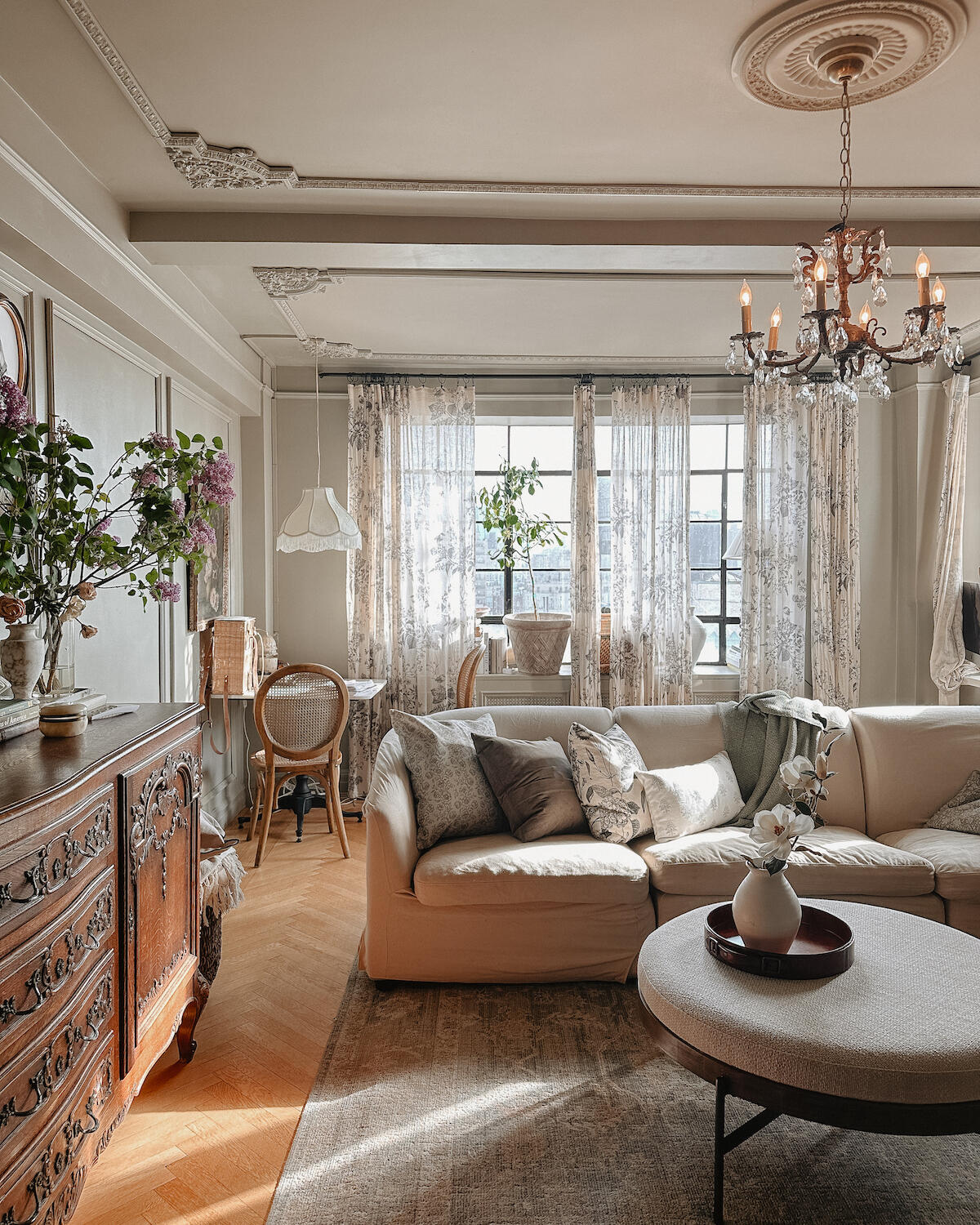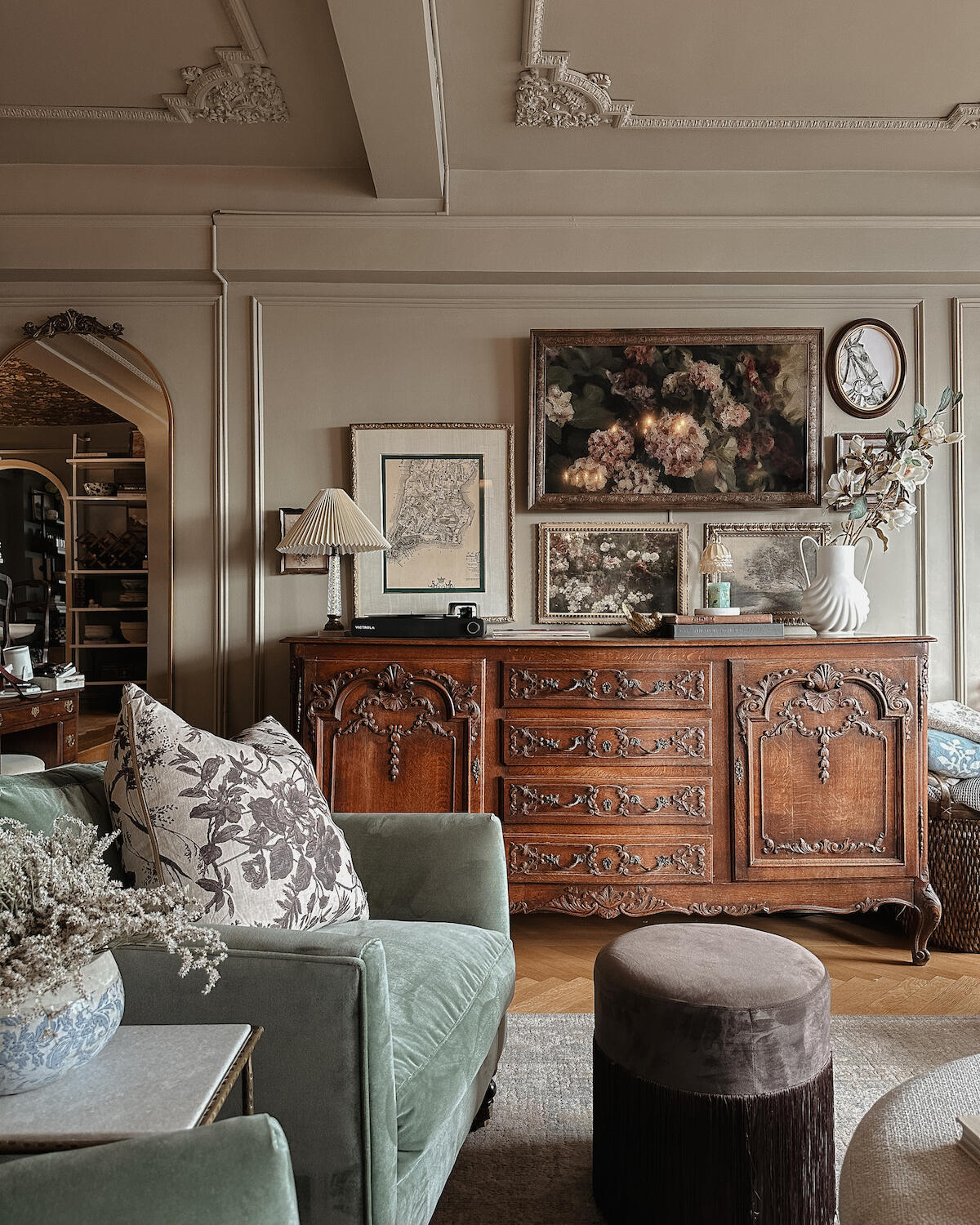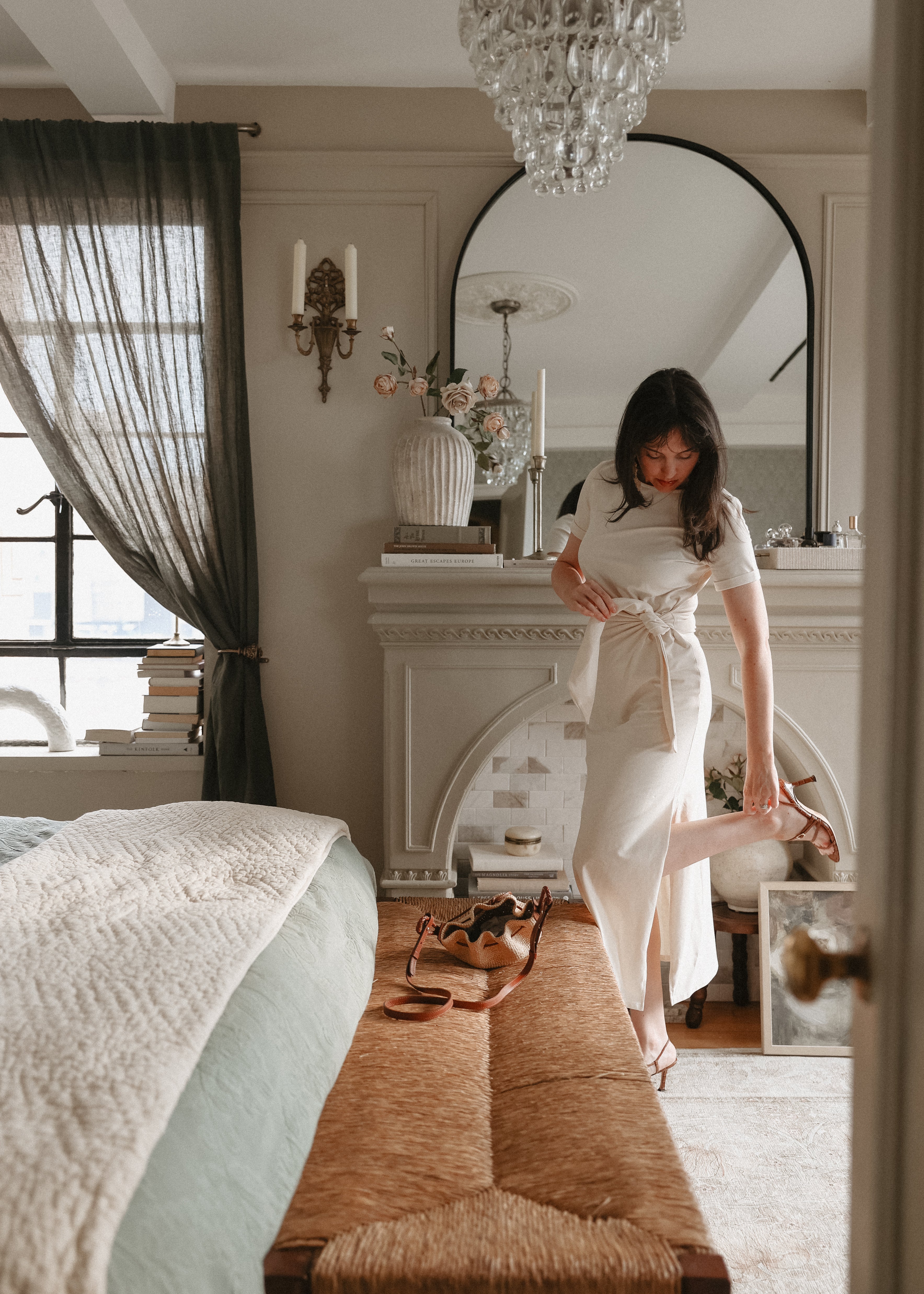In Ask an Influencer, Business of Home explores the creator economy. This week, we spoke with Shelby Vanhoy, the content creator behind lifestyle blog Pretty in the Pines.
It was 2014, and Shelby Vanhoy’s career plans were set: She had worked hard throughout college in preparation for dental school, and would soon ace her prerequisite exams and embark on the next phase of her journey. Starting a blog, she thought, would provide a great creative outlet along the way. The same year, she launched the lifestyle blog Pretty in the Pines to document her decorating-on-a-budget schemes along with snippets from her daily life. It only took a few short years for the then–early stage social media industry to kick into high gear—a change that swiftly turned her professional ambitions upside down.
“I saw the industry completely change around 2016 or 2017—that’s when I started actually earning money from my blog,” says Vanhoy. “My interest [in dentistry] honestly just faded away as I was diving into this new creative job.”
In February 2020, Vanhoy and her husband moved into a new Upper West Side apartment in New York, where they were promptly confined when the pandemic lockdowns set in just a few weeks later. Sensing an opportunity, she decided to double down on her usual new-home renovation efforts—this time producing more content, including video. With a full-time focus, her online presence flourished: Today, Pretty in the Pines has 410,000 Instagram followers and 143,000 YouTube subscribers.
Ahead, Vanhoy shares how partnering with a management company has freed up her creative time, the rewards she’s reaped from training her brain to think video-first and why YouTube is far better for design-focused content—and more lucrative—than most designers think.

When did you first start approaching social media with a strategy?
At the beginning, I would write blog posts frequently, but Instagram was still fairly new, there was no TikTok—in fact, there were so many platforms and features that didn’t exist. Over time, the focus shifted from blog posts to Instagram posts. Instagram is still the most important platform to my business, in addition to YouTube. But it’s all completely shifted to video now, and it’s about quality versus quantity. Instead of posting photos multiple times per day, I’m posting one well-thought-out short-form video. I’ve really had to train my brain to fully shift and think creatively in terms of video versus photo. Even from brands that I work with, I’ve noticed a huge increase in video requests. There was a while when Instagram was prioritizing video content. All business and brands accounts realized that your reach is just a lot higher when you post videos versus photos. I had to learn how to adapt to that change.
What does the content creation process look like for you behind the scenes?
I break it up into three main stages. The first is the planning and prepping, which includes writing a complete shot list and figuring out if it’s going to be a quick before-and-after video or if it’s going to be a tutorial where I show every single step. The next stage is shooting or filming, and after that it’s editing and submitting—and when I edit, I find the right music and add text overlays to help tell the story. Most of my time doesn’t even go into shooting; it’s the planning of what it is actually going to look like.
I’m always trying to figure out how I can relate [my content] to other people’s home situations. A lot of people follow me for renter-friendly content, so I try to make a project renter-friendly and highlight certain [relevant] products. My interests have shifted as I’ve gotten older, which has resulted in my content shifting. I share more food-related content now, because I’ve had to cook since having a kid. It’s always a reflection of my life. I’ve never been one to have a very strong niche—I’ve always shared a multifaceted mix of what genuinely interests me.

What does the physical process of producing content look like for you?
All of my videos are shot on an iPhone, and then I edit them on an app called Splice. I used to think that I needed a lot of fancy equipment before getting started, but iPhone content performs better than more highly produced content on more advanced cameras. I do post longer videos on YouTube, and for those I’ll use Final Cut Pro for editing—but even my long YouTube videos are filmed on an iPhone. Some of my photos are taken on a nicer Canon camera, especially if a brand requests high resolution images, and I’ll use Lightroom to edit photos on my desktop.
When did YouTube come into the picture for you?
I started sharing more frequently on YouTube when we moved to New York, documenting every room in that apartment, and I noticed that the YouTube community really enjoyed watching videos that went into depth about these different projects. The people who follow my YouTube are completely different from the ones who follow me on Instagram—some people really like watching the slower, longer 10-minute videos versus a 20-second video.
What’s nice about YouTube is that the company pays you every month based on your views. It’s not that much, but it’s definitely the highest compared to any other social media fund. And then for partnerships, brands will ask for a 30-second integration of a product or their brand in your video, which is nice because you don’t have to make the whole video about that one brand. It feels a little easier to slide in the products and tie it into a much larger story that you’re telling in the YouTube video. But it’s a totally different way of working with brands—sometimes they will request that they want to be mentioned in the first minute, while others don’t have that requirement. Because there’s so much video content outside of that integration, I have more control over the video as a whole. It’s also more direct and obvious—like, “This video is sponsored by so-and-so.” It feels almost like a commercial within a video, but it usually ties back to the theme of your video.
Is the content creation process different for YouTube?
I’ll film it over a longer period versus an Instagram video. So I’ll have an introduction, the steps of what I’m doing and then an outro. It’s a more in-depth planning process. I really enjoy creating vlog-style videos because it’s something that I can look back on. That’s the thing: With YouTube, I feel like brand partners get much longer-term benefits than from an Instagram video [that ends up getting archived in your Stories, Reels or grid]. Plus, a video on YouTube could go viral a year after I post it—that would never ever happen with an Instagram video. It feels very much like a search engine. If someone Googles “renter-friendly kitchen makeover,” your chances of showing up in that is much higher than if it were only posted to a platform like Instagram.
What was the path to growing your audience on social media?
On Instagram, it has been slow and steady growth since starting back in 2014. When YouTube created its version of Reels and TikTok—the YouTube Shorts feature—I just repurposed Instagram videos. A month or two ago, a YouTube Short of mine went viral, and that increased my following on YouTube by about 50,000 subscribers. It was crazy growth—YouTube even sent a silver plaque for the milestone! So now that’s definitely a platform-within-a-platform that I make sure that I’m posting on a couple of times every week.
Certain qualities about a video—like a voiceover or telling a story—do really, really well on YouTube Shorts. On Instagram, I have a few different formats of videos [that use] different transitions. It does feel like every platform has its own style—something that does well on Instagram definitely doesn’t always do well on TikTok, which itself is a whole different world.
How do you work with brands?
Brand partnerships are probably 70 percent of my business. The other streams of income are affiliate sales from sharing links to products and making a percentage—like commission—on those products, which is done through various networks like LTK and Collective Voice and Amazon. I also sell photography through a small Etsy shop, which is a very small part of my business. And then being paid directly through YouTube is the fourth stream of income.
Where do those relationships typically begin for you?
These days, they’re reaching out to me. I have a management team that helps me with negotiating, coming up with contract terms, and discussing exclusivity and usage rights, and they come up with my rates based on all of those factors. I’ve had a few different managers, but I have worked with the same management company since 2018, and it really made my life a lot easier. They see so much in the industry and they work with so many other creators, so they have a lot of knowledge on what is a reasonable rate. They’ve also saved me a lot of time, because the agency will go back and forth with the brand, which freed up a lot of time for me to focus on actually creating the content. They do take a percentage of the total rate, but it has been so worth it in my experience.
How did you get started there?
I remember applying to work with them back in 2017, and they said no. But then I noticed that the owner of the agency started following me—I think she just wanted to get to know my content more and see if I was a good fit. About a year later, she reached out and they were interested in working together. These days I don’t think that there’s a limit or requirement for the number of followers; I think it’s more about the business that you’re already bringing in before working with them. They want to make sure that you’re already working with brands frequently, because they don’t necessarily bring me a lot more work. I think a lot of people assume that that’s going to happen with an agency—they have brought me a lot of great opportunities, but the majority of my business starts out by coming directly to my inbox.
How much of yourself do you show on social media?
Since the beginning, I have shared a lot of myself. It has been a journey of getting more and more confident in that—Instagram Stories did not exist when I first started, so there was a time when I had to hype myself up to talk on my Stories. I’ve definitely found a balance of what I feel comfortable sharing too—and there’s a lot of personal life that I don’t share on social media. Especially since having a child, I’ve really stepped back a bit from what I share.

Do you respond to comments, DMs?
I try to. On my calendar, I have a checkbox that says: “Answer Instagram comments.” And there are also TikTok comments and YouTube comments. I have had to find a way to make sure that the majority of them are being answered on every single platform, because there have been instances—like on YouTube—where someone was like, “You didn’t answer my question.” You never know, that one interaction could lead to a really nice person following you for a long time.
What job title do you use?
I’ve never been a huge fan of the word “influencer” because my goal is not really to influence. “Content creator” sounds a little bit more like a good fit, but there’s so much more to it than just creating content. Especially working in the home space, there’s so much design that is behind it. When people ask what I do, there’s never really a great, quick name for it, in my opinion.
What’s the biggest challenge for you on social media right now?
I think the biggest thing is just not spending too much of my time on social media, even though it is my business. It feels overwhelming, but I’ve worked so many jobs before this and I feel more fulfilled doing this—and there’s a lot more flexibility in my life, so I’m OK with it. But it is an overwhelming feeling to know that your business never shuts off, and your brain never stops thinking about it. It’s very hard to just post and then tell yourself that you’re done for the day and you need to go take care of your child. Because the more you’re on there, the more it grows, and then more your business thrives. And there’s always a new platform, and new platforms within platforms. But realistically, you need to have a life outside of social media. It’s really a challenge finding a balance between keeping your business active on social media while also staying active in your personal life.




























